Getting Around Tallinn

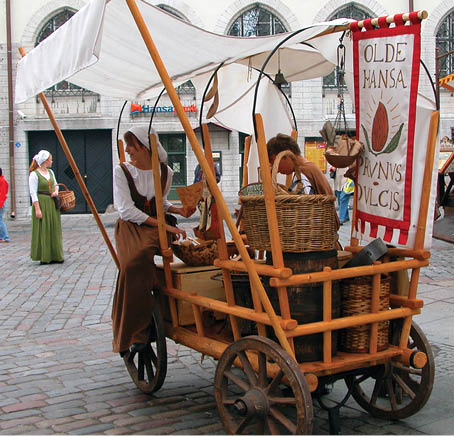
Almond seller in the Old Town.
The cruise port is about a mile (1.6 km) from the gates of the Old Town, and it takes approximately 20 minutes to walk the distance. Most cruise lines provide a shuttle service for a small fee, with a drop-off outside the main entrance of the Old Town. A red Hop-On Hop-Off bus makes regular stops at the cruiseship terminal while following its route in and around the Old Town; the fare is 19 euros for a one-day pass. Taxis are also available but fares are unregulated, so be sure to check the operator’s price list to determine his starting fare (2 to 5 euros) and metered fare per kilometre (.5 to 1 euro).

Shops line the Old Town streets.
Tallinn is just across the Gulf of Finland from Helsinki, and the Scandinavian influence is evident in Estonian design, be it furniture, fashion or home textiles. Items to look for in Tallinn include Estonian knitwear, amber jewellery and glass art. The streets of the Old Town contain numerous art galleries, fashion shops and jewellery stores.

Numerous restaurants line Town Hall Square.
Outdoor cafés are plentiful in the Old Town, especially at Town Hall Square, where the Olde Hansa recreates a medieval atmosphere for diners with its traveller’s luncheon of smoked herring, anchovies, liver paté, rye breads and thick soups. Cafes and restaurants are also tucked into the streets leading off the main square, such as Café Maiasmokk (Sweet Tooth Café) at Pikk 16, which is housed in a 200-year-old candy factory and serves wonderful cakes and coffee. Small packets of roasted sugared almonds – sold from food carts in Town Hall Square – are good for snacking as you walk the cobblestone streets.
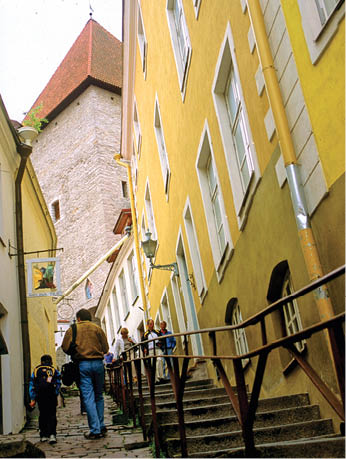
Ascending to the Upper Town.
The Old Town is a delight to explore on foot, with cobblestone lanes leading to half-hidden courtyards and church squares. The following is a suggested walking route through the Lower and Upper Towns.
1. Viru Gate – Marked by two 14th-century towers, this gate is the main entryway leading into the Old Town along Viru Street.
2. Town Hall Square – A busy shopping street, Viru leads to cafe-lined Town Hall Square (Raekoja Plats), site of Tallinn’s medieval marketplace. This central square is still a hub of activity with outdoor concerts, festivals and crafts fairs held here. Residents dressed in medieval costume invite tourists to sample the medieval fare served in such restaurants as the Olde Hansa (housed in the old Packing Hall) or Peppersack (housed in the residence of a Hanseatic merchant). The 14th-century Town Hall is open in summer to visitors, its cellar containing a model of 16th-century Tallinn, and a climb to the top of its tower (115 steep steps) provides sweeping views. The 15th-century Town Hall Pharmacy is one of the oldest in Europe that is still functioning at its original spot in the square.
Map of Tallinn
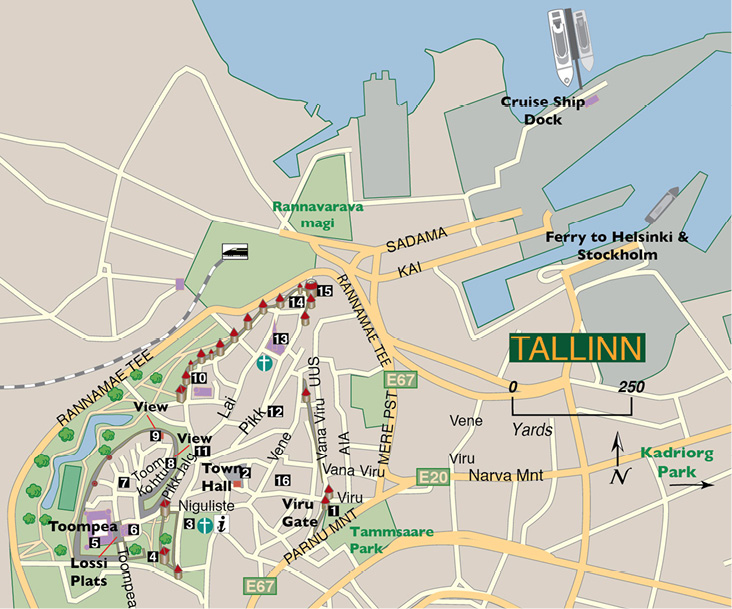
3. St. Nicholas’s Church – Crossroads lead in all directions from Town Hall Square. If you follow Kullassepa to Niguliste, you will come upon the (i) Visitor Information Centre where you can pick up a detailed walking map. Niguliste Street runs along one side of St. Nicholas’s Church (Niguliste Church), which was built by German merchants from the island of Gotland in the early 13th century. Restored following WW II bombing raids, the church is today a concert hall and museum dedicated to church art.
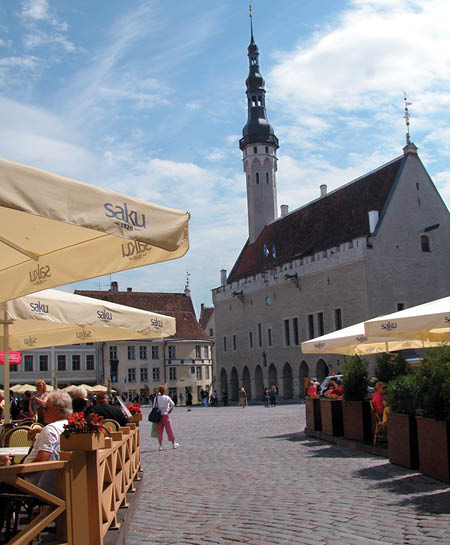
Town Hall.
4. Kiek-in-de-Kok – Continuing along Niguliste Street to Luhike Jalg Street, which ascends to the Upper Town, you will pass the Danish King’s Garden on your left before proceeding through a gate tower to Toompea (Cathedral Hill), site of the Danish-built castle. Before heading to Toompea’s main square (Lossi Plats), a detour to your left will lead to a 15th-century tower called Kiek-in-de-Kok (Peep in the Kitchen) so named for the vantage it provided into kitchen windows in the Lower Town. Today this cannon tower houses a museum featuring narrow stairways and access to the secret tunnels built beneath the Old Town.

Estonian Parliament building.
5. Estonian Parliament – The original 13th-century Danish castle on Toompea has undergone much reconstruction over the centuries, including the addition of an 18th-century building that today houses the Estonian Parliament.
6. Alexander Nevsky Cathedral – Standing opposite the Estonian Parleiament, this cathedral was designed by a St. Petersburg architect and completed in 1900 when Tallinn was part of Imperial Russia.

Dome Church.
7. Toomkirk – Nearby is Toomkirk (Cathedral of Saint Mary the Virgin), which is also called Dome Church. Its original stone structure dates to the mid-1200s, with additions and modifications added since.
8. Kohtu Viewing Platform – Kohtu Street leads from Toomkirk to Kohtu Viewing Platform from which you can enjoy a view overlooking the Lower Town.
9. Viewing Platform – Another viewing platform is entered through an arch off Rahukohtu.

A street in Old Town.
10. Nunna, Sauna and Kuldjala Towers – To return to the Lower Town, follow the long sloping street Pikk Jalg to the tower archway that leads onto several streets branching off in various directions. From here, you can continue to the far end of the Lower Town, or you can return to Town Hall square. Attractions to be seen on an extended walking tour include a section of the medieval wall that connects Nunna, Sauna and Kuldjala Towers where visitors can climb up to the ramparts to enjoy splendid views.
11. Estonian History Museum – A major attraction on Pikk Street, this museum is housed in the preserved Great Guild Hall, which was built by the town’s wealthy merchants from 1407 to 1417 and displays the Great Guild’s coat of arms on its façade.
12. House of the Brotherhood of Black Heads – Located further along Pikk Street at #26, this house is a military fraternity of bachelor merchants; their emblem is positioned above the doorway of this 16th-century building, which features an ornate façade reflecting the Dutch Renaissance style.
13. St. Olav’s Church – A rebuilt Gothic church that was once the tallest in medieval Europe, standing near the end of Pikk Street. Its soaring spire has been struck by lightening at least eight times and the church has burned three times. During the Soviet era, the spire was used by the KGB for sending radio transmissions.
14. The Three Sisters – Located at the far end of Pikk Street, these buildings are the former residences of three Hanseatic merchants, which now house a luxury hotel.
15. Maritime Museum – Marking the very end of Pikk Street is the Great Coastal Gate and Fat Margaret’s Tower, the latter housing Tallinn’s Maritime Museum.
16. St. Catherine’s Passage – If you are planning to walk back to the ship, this exit from the Old Town is closest to the cruise piers. If you are planning to walk back through the Lower Town to the Viru Gates and catch the shuttle back to the ship, be sure to stroll through St. Catherine’s Passage – an enclave of craftsmen’s workshops and artisans’ studios lining a narrow medieval passageway that connects Vene and Muurivahe streets.
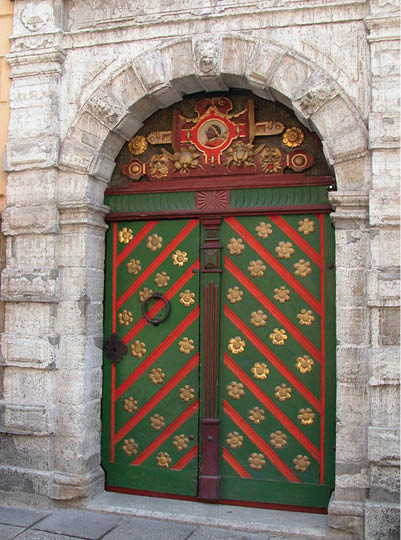
Doorway of House of the Brotherhood of Black Heads.
The Museum of Occupation and Fight For Freedom, which opened in 2003, is located just outside the Old Town at Toompea 8. Housed in a modern building, the museum is dedicated to Tallinn’s years of Soviet occupation.
The stately Kadriorg area, about a mile east of the Old Town, is where Peter the Great built a baroque summer palace and gardens for himself and his wife Catherine. Today the czarist palace houses the Kadriorg Art Museum and standing opposite, on the far side of the gardens, is the Presidential Palace. The palace’s park-like setting encompasses several historic outbuildings, including Peter the Great Cottage, as well as the ornamental Swan Lake. Numerous foreign embassies are located in the Kadriorg area, as is the Kumu Art Museum, which opened in 2006 and exhibits both classical and contemporary Estonian art. Also in the Kadriorg area is the Song Festival Grounds, with its modern amphitheatre and where the Singing Revolution began in 1988.
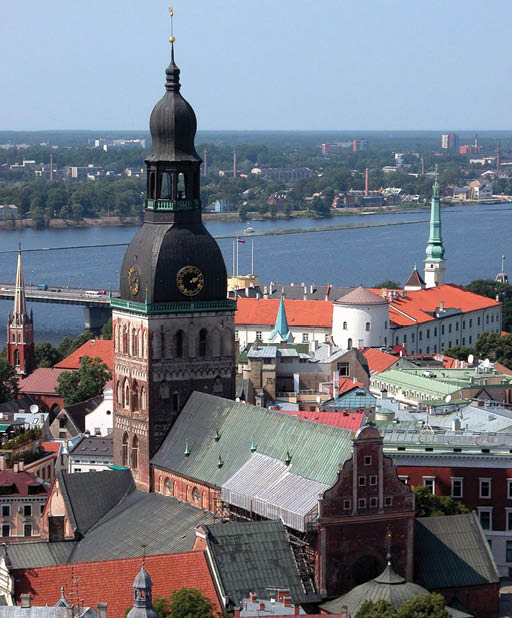
Riga’s cathedral.
Situated on a natural harbour lying upriver from the mouth of the Daugava River, Riga has been an important trading centre since the time of the Vikings and subject to foreign rule since the 13th century. When Latvia gained independence from the Soviet Union in 1991, Riga was initially plagued with poverty and crime, but has since revitalized itself and is a growing tourist destination. The old town has retained its medieval character and the Art Nouveau district contains an unparalleled collection of Jugendstil buildings for which Riga’s historic centre has been declared a UNESCO World Heritage Site.
The cruise ships dock at the ferry terminal, which is a half-mile (.8-km), 15-minute walk along the waterfront to Old Riga (the city’s historic centre). Most cruise lines provide a shuttle for a small fee. Metered taxis are available (be sure your driver displays an operating licence). Tram cars connect the ferry terminal with the city centre.
Map of Riga

The Republic of Latvia, wedged between Estonia and Lithuania, has a population of 2 million. The majority is ethnic Latvian, but a quarter of the population is Russian due to decades of Soviet domination. Latvian is the official language and schoolchildren learn English as a second language. Lutheran and Orthodox are the two major religions, and the system of government is a parliamentary democracy. Riga is the capital and largest city of Latvia with a population of 700,000. The city’s most famous son is Isaiah Berlin, born in Riga in 1909 when Latvia was part of the Russian Empire. Latvia joined the European Union in 2004 and its unit of currency is the euro.
Amber jewellery and Soviet memorabilia are popular souvenirs in Riga. Cafes serving beef stroganoff and Latvian beer are numerous in the Old Town, especially at Cathedral Square. The city’s Russian tearooms are perfect for an afternoon snack.
1. Powder Tower – Riga’s old section (Hansa town) is encircled by a park-lined moat where the fortified city’s walls were once protected by a series of medieval towers. Powder Tower, the only one remaining from the original walls, houses the Latvian Museum of War.
2. Castle of the Livonian Knights – This ancient castle has been rebuilt over the ages and is today occupied by the Museum of Latvian History, Museum of Foreign Art and the Latvian president’s official residence.
3. The Latvian Parliament Building – This building, built in the 19th century on Jekaba Street, was barricaded by the Latvian Popular Front to prevent the Soviet Army from reaching it during the country’s independence movement in the early 1990s.
4. Dome cathedral – Cathedral Square (Doma laukums) is the centre of the medieval town. Here stands the 13th-century Dome cathedral, which was built by Bishop Albert (Riga’s founder) in 1221 and rebuilt in the 16th century.
5. Museum of Riga’s History and Navigation – Located beside the Dome cathderal, housed in a converted monastery, this museums began with the private collection of a Riga doctor.
6. The Three Brothers – A trio of stone houses on Maza Pils, the oldest being No. 17 (dating from the 15th century) and No. 19, now housing the city’s architecture museum.
7. Latvian Occupation Museum – The box-shaped Latvian Occupation Museum chronicles the country’s Soviet era of occupation.
8. House of the Blackheads – A 14th-century inn featuring an ornate Dutch Renaissance facade that was reconstructed in honour of Riga’s 800th birthday in 2000.
9. St. Peter’s Church – First built in 1209, its soaring spire completed in 1746. Soviet engineers restored the church in the 1970s and installed an elevator in its tower for views over the city.
10. St. John’s Church – A 13th-century chaped located on the next street is.
11. National Opera House – Richard Wagner was once music director of the local opera, and the city’s neo-classical National Opera House, built in 1863 and rebuilt following a fire in 1882, is a monument to Riga’s rich musical heritage. It stands on the edge of Vermane Park, which lies along Pilsetas Kanals – a canal that winds through the city, dividing the Old Town from the New Town.

12. Freedom Monument – It’s a short canalside walk from the Opera House to the Freedom Monument, unveiled in 1935 and rising high above the spacious plaza. The monument is a symbol of freedom and national independence for Latvians, who would rally at its base during the Soviet era.
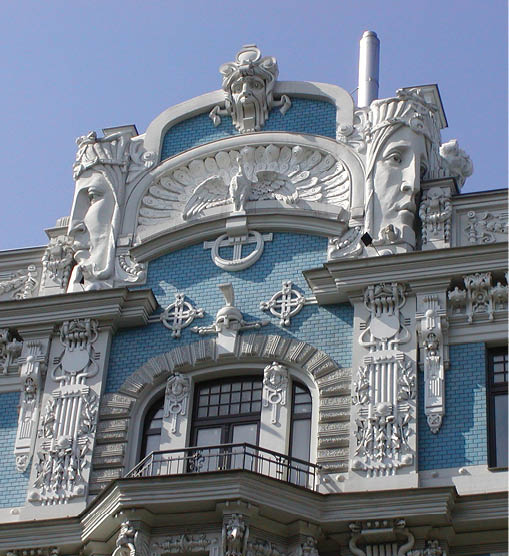
Art Nouveau architecture on Elizabetes iela.
13. The National Art Museum – This museum showcases Latvian fine art and is located on the far side of the Esplanade, a parkland of formal gardens and period mansions. Lying northwest of the Esplanade is the Art Nouveau District where late 19th- and early 20th-century apartment buildings were designed in the Jugendstil (German for ‘youth style’). The elaborate façades of these buildings include several by the Mikhail Eisentein, who was born in St. Petersburg of Swedish and Jewish-German ancestry. Buildings of note by Eisentein include Elizabetes iela 10b; Alberta iela 4, 6, 13 (the Belgium Embassy is on the 5th floor of No. 13); and Strelnieku 4 (housing the Stockholm School of Economics).
14. Open Air Ethnographic Museum – Outlying Riga attraction which is located about five miles (9 km) from the city centre.
15. Riga Motor Museum – Housed in a modern building which opened in 1989, its exhibits including Stalin’s armoured limousine.
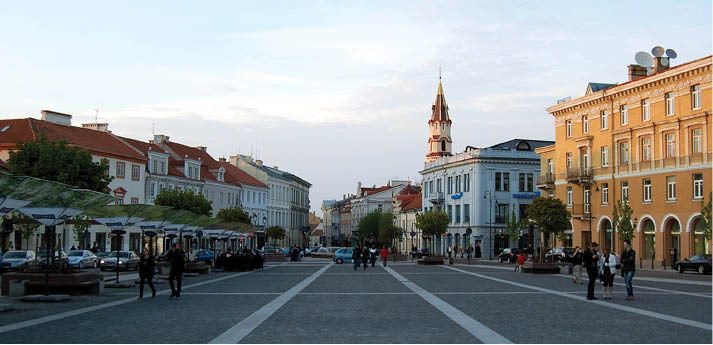
Vinius’s historic quarter
Once encompassing most of present-day Belarus and Ukraine, then forming a commonwealth with Poland in 1569, the large European state of Lithuania was eventually partitioned by surrounding countries to become the small republic of today. The country’s Baltic port of Klaipeda has been ruled at various times in its history by the Teutonic Knights, Prussians, Germans and Soviets. Modern Klaipeda is an emerging port of call for visiting cruise passengers who stroll the cobblestone streets of the medieval Old Town to view such highlights as Theatre Square and the Amber Market. Excursions are offered to Zemaitija National Park, where a former Soviet nuclear missile launch site is nestled amid the forests and lakes of this scenic nature reserve. Also visited on an excursion from Klaipeda is the historic town of Kretinga, which is home to a Benedictine monastery.
Lithuania’s population of 3.5 million is predominantly Lithuanian (with small minorities of Russians and Poles) and about 80% of the population is Roman Catholic. Like its Baltic neighbours Latvia and Estonia, Lithuania is a parliamentary democracy. The capital is Vilnius, which was founded in 1323 when the Lithuanian prince Gediminas built a castle there.
Lithuania joined the European Union in 2004 but its unit of currency is the litas. The approximate exchange rate is $1US = 2.2 LTL.